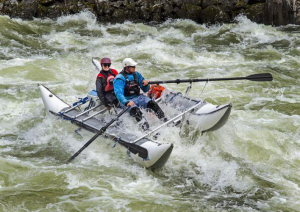A raft with patches on the bottom is a warning sign that it has been punctured. The fewer the patches, the better. Look for patches that have not come off the raft and should not be duct taped. Look for hardware, too. If it has been glued on, it’s probably not the raft you want. Gluing hardware isn’t a big deal if you replace it later.
Catarafts are more maneuverable than self-bailing rafts
 While self-bailing rafts have a lot of benefits, catarafts aren’t for everyone. The narrow, lightweight frames of catarafts don’t leave much room for overnight gear. The lack of a centre pontoon means passengers can’t put everything in one place and aren’t as safe as traditional rafts. Unlike a self-bailing raft, a cataraft must be tied onto the pontoons with a rope.
While self-bailing rafts have a lot of benefits, catarafts aren’t for everyone. The narrow, lightweight frames of catarafts don’t leave much room for overnight gear. The lack of a centre pontoon means passengers can’t put everything in one place and aren’t as safe as traditional rafts. Unlike a self-bailing raft, a cataraft must be tied onto the pontoons with a rope.
Another advantage of a cataraft is its weight and ease of setup. A cataraft is more maneuverable than a self-bailing raft, which makes it easier to manoeuvre around the river and handle waves. It is also much easier to transport and store than a standard raft. It can even accommodate seven paddlers. So whether you’re planning a family day trip or a romantic weekend with friends, a cataraft can fit the bill.
If you’re looking for a sporty ride, a cataraft is the right choice. Although these boats aren’t as maneuverable as a self-bailing raft, they can be used to float on the water. The only difference between the two is the safety factor. While self-bailing rafts are great for safety, they’re not recommended for whitewater.
Another advantage of a self-bailing raft is its versatility. They don’t need buckets to drain water. That feature can be crucial in higher water levels and a real boon in big rapids. However, some guides argue that self-bailing rafts track better than self-bailing rafts, which means that they don’t have to make as many micro-corrections in the middle of the river.
They are lighter than self-bailing rafts
When choosing a whitewater Outdoor Play rafting, you must consider its size and weight. While they are a little less fast than self-bailing rafts, they’re surprisingly durable and safe. If you plan on navigating swift, boulder-strewn rapids, you may want to opt for a raft. It would be best to consider safety, stability, and ease of use regardless of style. Bushcraft Hungry is a good source of outdoor gear.
The material of the raft’s body will be based on its intended use. Most rafts are made from a combination of three materials: urethane, PVC, and Hypalon. Urethane is light and durable but can be expensive and difficult to store. PVC is less expensive but can be damaged by UV light. Hypalon-constructed rafts have a higher price tag.
A few materials are better than others for rafts. Urethane is lightweight but offers superior resistance to chemicals and UV light. While it’s more expensive than Hypalon, the raft’s overall weight is more manageable. Besides, they are more flexible and easy to roll. Despite its higher price, Hypalon rafts are better than PVC in many ways.
They are more expensive than self-bailing rafts
Regarding materials, there are two main choices: PVC and Hypalon. PVC is cheap and light, while Hypalon is more durable and resistant to chemicals. However, the downside of PVC is that it doesn’t hold up as well to UV rays and other chemicals. To compensate for this weakness, most manufacturers use other coatings on the material to make it more chemically resistant. For example, narrow rafts are more stable but weigh more, and wide ones are easier to control.
They are less expensive than self bailing rafts
The price difference between a self-bailing raft and a bucket raft is mainly due to their different construction. While bucket rafts are made of a solid wooden frame, a self-bailing raft has holes on its floor where water can exit. In addition, a self-bailing raft has a floor made of a thick inflated chamber. As a result, water splashing into the raft moves across the floor, flows over the top, and exits the bottom through the holes.